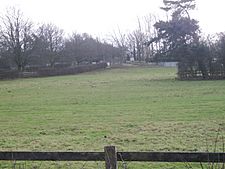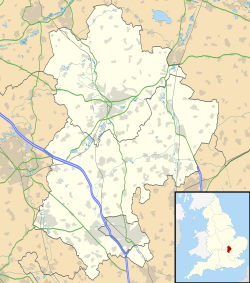Risinghoe Castle facts for kids
Quick facts for kids Risinghoe Castle |
|
|---|---|
| Bedford, Bedfordshire, England | |

Viewed from Goldington Road
|
|
| Coordinates | 52°08′44″N 0°24′29″W / 52.14568°N 0.40806°W |
| Type | Castle |
| Site information | |
| Condition | Earthworks |
Risinghoe Castle, also known as Goldington Castle, is a large mound of earth in Bedford, England. It stands about 20 feet high. This historical site is located near the River Great Ouse. It is about three miles east of Bedford Castle. It is also one mile west of Renhold Castle.
Risinghoe Castle is found in what used to be the village of Goldington. This village is now part of the town of Bedford. The castle site is officially in the Newnham area of Bedford.
Contents
What Was Risinghoe Castle?
There is some debate about what Risinghoe Castle actually was. Many experts believe it was a type of castle called a Motte-and-bailey castle. This kind of castle was made of timber and earth. It was likely built after the Norman Invasion in 1066.
Early Owners and History
Records suggest that the castle belonged to Hugh de Beauchamp. He was a major landowner in Goldington around 1086. By the late 1100s, the castle was already considered old.
Later, the land, including the castle site, became part of Wardon Abbey. An abbey is a type of monastery. After the Dissolution (when King Henry VIII closed many monasteries in the 1500s), the property went to Sir John Gostwick. Eventually, it passed to John Russell, Duke of Bedford.
Missing Castle Parts
Today, there are no clear signs of a "bailey" at the site. A bailey is the enclosed courtyard of a motte-and-bailey castle. This might be because a lot of clay was dug up from the site in the Victorian era. This digging could have removed any remaining evidence.
Digging for Clues
Some people say the mound was dug into in 1943. However, there are no official records of this dig. The local history society's report from that year does not mention it.
Another story from local people says the mound was dug into in 1940. This was to build an air raid shelter during World War II. They say nothing was found inside. If this is true, then no professional archaeological dig has ever happened there.
Another Idea About the Mound
In 1920, a researcher named Beauchamp Wadmore wrote a book. He questioned if Risinghoe was truly a castle site. Wadmore thought the mound might have been built much earlier. He believed it could mark a victory over the Danes in the 800s. This victory was linked to a nearby place called Gannocks Castle.
Wadmore also mentioned that there used to be a second, smaller mound. This was before the site was damaged by clay digging. However, an early map from the Ordnance Survey (a mapping agency) does label it as a castle site.
Visiting Risinghoe Castle
Risinghoe Castle is on private land. This means it is not open for the public to visit. However, you can see the mound from a distance from the nearby road.


